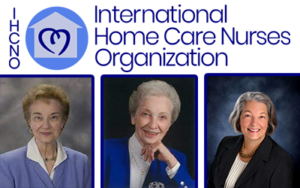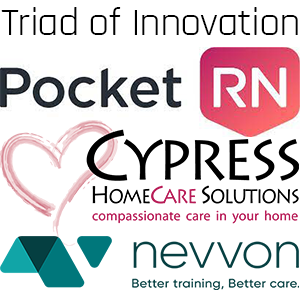HHAeXchange Makes Leadership Changes
Vendor Watchby Kristin Rowan, Editor
On February 21, 2024, HHAeXchange announced a change in leadership for the homecare management solutions company. Former Chief Revenue Officer Scott Schwartz was named Chief Operating Officer and new hire Lori Harrington came on board as the Senior Vice President of Product. You can read the press release from HHAeXchange here.
HHAeXchange provides management solutions for providers, MCOs, and state Medicaid agencies. The software was designed specifically for home and community-based services (HCBS) and connects state agences, MCOs, providers, and caregivers through its web-based platform. According to HHAeXchange, the personnel changes show the company’s “commitment to providing innovative solutions that some homecare industry challenges.
I had the opportunity to reach out to Scott and Lori to get, in their own words, their visions for the future of HHAeXchange and the industry.
The Rowan Report: Thank you, Scott and Lori for taking some time to talk with The Rowan Report. First, congratulations to you both on your new roles. Can you each share a little about your background and career?
Scott Schwartz: For over 20 years, I’ve focused on system of record, vertical SaaS software and technology, with experience leading sales, marketing, client success and operations. I started my career as a process engineer and have held leadership positions at several SaaS companies, including as the founder and general manager of CampSite. I joined HHAeXchange in 2017 as vice president and have also served as senior vice president and chief revenue officer before stepping into my current role. As chief operating officer, my aim is to galvanize the organization around a shared vision of operational efficiency, innovative service delivery, and customer satisfaction.
Lori Harrington: I have enjoyed a career of over 20 years in healthcare with a background in product strategy and informatics. In my most recent role as vice president of product management at Teledoc, I led product strategy for value-based care initiatives. My passion for digital transformation in B2B2C markets has driven successful healthcare initiatives from ideation to commercialization. I believe that success in healthcare is really understanding your users and building solutions to solve their everyday problems in a seamless, understandable way.
RR: Scott, as part of your new responsibilities at HHAeXchange, how will you ensure effective communication and collaboration between internal departments to better serve customers?
Scott: We’re focused on enhancing our platform, which connects state agencies, managed care organizations, providers and caregivers, so cross-departmental communication and collaboration are vital. With shared services such as implementation, revenue cycle operations, integrations, technical customer care, training, and customer education under my purview, I plan to streamline communication pathways and ensure all teams are aligned with and working toward our common goals.
We want to leverage our teams’ diverse talents to drive transformation. My approach includes fostering an integrated work environment where interdepartmental meetings, clear information channels, and shared objectives are the norm. Regular check-ins and transparent leadership are key to ensuring every department understands how their work directly benefits our clients, the members they serve, and the company’s broader goals.
RR: And how will you ensure HHAeXchange’s solutions and product enhancements meet the needs of all homecare stakeholders – caregivers, provider agencies, members, and payers?
Scott: Engaging with stakeholders is critical. We involve provider agencies, caregivers, payers and others in our development process to ensure that our platform addresses real-world needs effectively. Our comprehensive engagement strategies support this with initiatives like periodic customer summits, road shows, and information sessions to capture a wide array of insights and feedback.
We monitor industry trends, regulatory changes, and technological advancements, which are factored into planned enhancements and solution updates. And with a team of reputable industry experts, we’re working to ensure that our products exceed the evolving needs of all homecare stakeholders.
Lori: We understand that stakeholders in the homecare space have diverse and critical needs. We keep a pulse on industry trends and challenges such as issues with caregiver turnover, regulatory & compliance changes, increasing volume of live-in caregivers, and an increase in diversification in home care utilization. With these observations, we aim to provide products that support healthcare agencies and caregivers as these trends evolve. Our solutions must be built with a nimbleness that accounts for a continuous change in regulations, EVV compliance requirements, and stakeholder expectations. Frequently engaging with stakeholders, conducting thorough market research, and incorporating feedback loops are integral to our product development processes.
RR: Lori, you mentioned the diverse needs of your stakeholders. What are the greatest problems your clients and prospects say they are looking to solve with improved homecare management software solutions and EVV platforms?
Lori: Our clients are prioritizing caregiver retention and looking for comprehensive solutions to streamline operational processes like billing, HR, and payroll while ensuring regulatory compliance and providing high-quality member care. They need tools to manage the diverse locations of members’ and workers’ schedules, foster strong member-caregiver matches, and enable transparent communications among provider teams.
Taking those challenges into consideration, HHAeXchange aims to equip our solutions with time-saving, stress-reducing features. Operational worklists, for example, alert agencies to important dates and actions their teams need to take regarding caregiver compliance and client authorizations. Our appointment module and case broadcasting feature reduce hassles associated with scheduling visits and quickly filling unexpectedly open shifts.
RR: Two questions, Lori. What trends are you seeing that are transforming homecare delivery models and, in addition to technology, are there any other trends shaping the homecare industry in 2024?
Lori: The ongoing caregiver shortage remains a concern, driving a shift toward more strategic technology investments and training opportunities. Homecare delivery is becoming more person-centered, suggesting the industry has adjusted to EVV and is using the technology to incorporate collaboration with families as caregiver participants. Additionally, there’s a growing emphasis on self-direction, with clients seeking more choice, flexibility and control in their care. Compliance is gaining more attention, with increased scrutiny to ensure standards of care are met across the board. Data and analytics will continue to be a primary enabler for how healthcare is shaped. We account for all of this in our product strategy and development plans.
RR: Final questions for you, Scott. How does HHAeXchange envision the homecare industry evolving in 2024 and, more specifically, how do you see the company’s innovations playing a role in that transformation?
Scott: The homecare industry is at a critical juncture. As Lori said, we’ve noted significant shifts toward value-based care, self-directed care, and person-centered approaches. At the same time, the fundamentals of homecare are as important as ever. HHAeXchange’s role is to stay ahead of trends while improving product offerings and customer experiences. We strive to balance innovative thought leadership with steady progress, continually enhancing the functionality of our foundational platforms to meet clients’ needs.
We’re investing in scalable technology, service improvements, customer education, and strategic integrations to accommodate the industry’s evolution. Our leadership is committed to empowering providers and payers alike with tools to improve caregivers’ efficiency and address fraud, waste and abuse in the industry. Through these efforts and plans, we aim to facilitate a more sustainable, higher-quality, and accessible homecare ecosystem for all involved, ensuring members have the option to receive care and treatment in the comfort of their own homes.
RR: Thank you both, again, for your time. I wish you both great success in your new roles.
# # #
 Kristin Rowan has been working at Healthcare at Home: The Rowan Report since 2008. She has a master’s degree in business administration and marketing and runs Girard Marketing Group, a multi-faceted boutique marketing firm specializing in event planning, sales, and marketing strategy. She has recently taken on the role of Editor of The Rowan Report and will add her voice to current Home Care topics as well as marketing tips for home care agencies. Connect with Kristin directly kristin@girardmarketinggroup.com or www.girardmarketinggroup.com
Kristin Rowan has been working at Healthcare at Home: The Rowan Report since 2008. She has a master’s degree in business administration and marketing and runs Girard Marketing Group, a multi-faceted boutique marketing firm specializing in event planning, sales, and marketing strategy. She has recently taken on the role of Editor of The Rowan Report and will add her voice to current Home Care topics as well as marketing tips for home care agencies. Connect with Kristin directly kristin@girardmarketinggroup.com or www.girardmarketinggroup.com
©2024 by The Rowan Report, Peoria, AZ. All rights reserved. This article originally appeared in Healthcare at Home: The Rowan Report. One copy may be printed for personal use: further reproduction by permission only. editor@therowanreport.com





 Tim Rowan is a 30-year home care technology consultant who co-founded and served as Editor and principal writer of this publication for 25 years. He continues to occasionally contribute news and analysis articles under The Rowan Report’s new ownership. He also continues to work part-time as a Home Care recruiting and retention consultant. More information:
Tim Rowan is a 30-year home care technology consultant who co-founded and served as Editor and principal writer of this publication for 25 years. He continues to occasionally contribute news and analysis articles under The Rowan Report’s new ownership. He also continues to work part-time as a Home Care recruiting and retention consultant. More information: 



